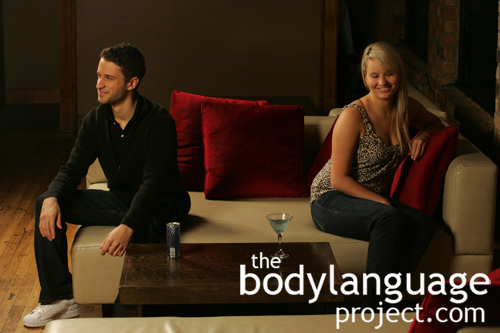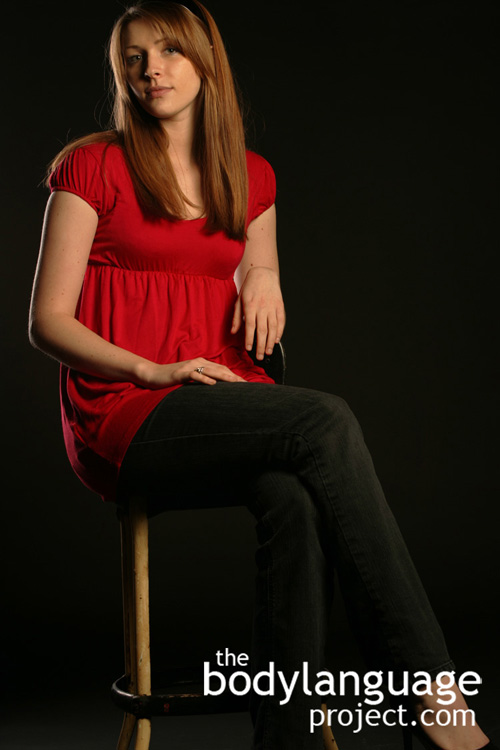Body Language of Eye Catch And Look Away
Synonym(s): N/A
Description: An immediate aversion of the eyes upon eye contact – either down or to the side.
In One Sentence: Eye catch and look away is a signal that one does not want to be noticed looking.
How To Use it: This is generally a cue you will not want to apply as it is perceived as being socially awkward. The exception worth noting, however, and one which women may find effective, is in a dating context. Women can catch the eyes of men and then quickly avert them. However, this is best done by looking down rather than away as this perceived as scanning. Usually eye contact is required to be coupled with a slight smile. When women break eye contact with men in this quick fashion, it tells them that they are submissive to their dominance. This is the most natural dating arrangement and is alluring for both parties.
Context: a) Dating b) General.
Verbal Translation: a) “I find you attractive but don’t want to be caught staring or showing too much interest. Besides, I find your attractiveness and dominance intimidating.”
b) “I made eye contact with you by accident and I am uncomfortable holding it for any length of time because I see you as more dominant than me.”
b) “I’m averting my eyes after eye contact because I don’t like you. I don’t want to talk to you or acknowledge you exist.”
b) “I caught your eye by accident as I was casually scanning the room.”
Variant: See Eye Aversion, Gaze Avoidance and Wandering Eyes, Downcast Eyes or Eyes Down.
Cue In Action: a) When scanning the room for someone to approach, he caught the eye of an attractive woman. She continued to scan the room rather than looking down and no smile was present – she was disinterested. b) He was angry and nearing a boiling point. Then he made eye contact with a young man to his dismay. The young man quickly averted his eyes pretending not to notice the raging veins about to burst through his forehead.
Meaning and/or Motivation: Eye catch and look away is defined by its context.
When done to strangers it indicates submission. Usually the weaker party will look away first while the more dominant might see eye contact as a personal challenge and hold his gaze longer.
Eyes that catch other eyes when scanning a room will continue to scan despite eye contact. This shows others that eye contact happened by accident and lacked intent or meaning.
In a dating context, eyes that look down after eye contact show submission while eyes that look left or right, as in a general context, simply mean that a person was scanning the room. Looking down is usually done by woman followed by a smile and other indicators of interest such as neck or wrist exposure, preening the hair or blushing due to nervousness.
Cue Cluster: Watch for submissive cues in people that habitually break eye contact first such as head lowered, shoulders shrugged, arms pulled in legs crossed tightly, touching the face and neck, and so forth. In dating, eyes that look away, right or left, rather than down signal lack of interest. A coy smile indicates the opposite especially when done by a woman.
Body Language Category: Appease, Dislike (nonverbal), Eye Language, Indicators of disinterest (IOD), Nonthreatening body language.
Resources:
Aguinis, Herman ; Simonsen, Melissam. ; Pierce, Charlesa. Effects of Nonverbal Behavior on Perceptions of Power Bases. The Journal of Social Psychology. 1998. 138(4): 455-469.
Aguinis, Herman ; Henle, Christinea. Effects of Nonverbal Behavior on Perceptions of a Female Employee’s Power Bases. The Journal of Social Psychology. 2001 141(4): 537-549.
Argyle, M., & Dean, I. Eye contact, distance and affiliation. Sociometry, 1965, 28, 289-304.
Beausoleil, Ngaio J. ; Stafford, Kevin J. ; Mellor, David J. Burghardt, Gordon M. (editor). Does Direct Human Eye Contact Function as a Warning Cue for Domestic Sheep (Ovis aries)? Journal of Comparative Psychology. 2006. 120(3): 269-279.
Brooks, C. I., Church, M. A., & Fraser, L. 1986. Effects of duration of eye contact on judgments of personality characteristics. Journal of Social Psychology. 126: 71–78.
Bowers, Andrew L. ; Crawcour, Stephen C. ; Saltuklaroglu, Tim ; Kalinowski, Joseph
Gaze aversion to stuttered speech: a pilot study investigating differential visual attention to stuttered and fluent speech. International Journal of Language & Communication Disorders. 2010. 45(2): 133-144.
Baxter, James C., and Richard M. Rozelle (1975). “Nonverbal Expression as a Function of Crowding During a Simulated Police-Citizen Encounter.” In Journal of Personality and Social Psychology (Vol. 32, No. 1), pp. 40-54.
Cook, M. Experiments on orientation and proxemics. Human Relations, 1970, 23, 61-67.
Chen, Yi-Chia ; Yeh, Su-Ling. Look into my eyes and I will see you: Unconscious processing of human gaze. Consciousness and Cognition. 2012 21(4): 1703-1710.
Davis 1978. Camera Eye-Contact by the Candidates in the Presidential Debates of 1976 Source: The journalism quarterly. 55 (3): 431 -437.
Davis, Flora (1971). Inside Intuition: What We Know About Nonverbal Communication (San Francisco: McGraw-Hill).
Ellsworth, Phoebe; Carlsmith, J Merrill. 1973. Eye contact and gaze aversion in an aggressive encounter. Journal of Personality and Social Psychology. 28(2): 280-292.
Friesen, C.K., & Kingstone, A. (1998). The eyes have it: Reflexive orienting is triggered by nonpredictive gaze. Psychonomic Bulletin and Review, 5, 490–493.
George, N., Driver, J., & Dolan, R. J. (2001). Seen gaze-direction modulates fusiform activity and its coupling with other brain areas during face processing. Neuroimage, 13, 1102–1112.
Gordon, A. K. and A. G. Miller. 2000. Perspective differences in the construal of lies: is deception in the eye of the beholder? Personality and Social Psychology Bulletin 26 (1): 46-55.
Gilliam, Harold V. B.; Van Den Berg, Sjef. 1980. Different Levels of Eye Contact: Effects on Black and White College Students. Urban Education. 15 (1): 83-92.
Goldman. 1980. Effect of Eye Contact and Distance on the Verbal Reinforcement of Attitude. The Journal of social psychology 111(1): 73 -78.
Greene 1979. Title: Need-Fulfillment and Consistency Theory: Relationships Between Self-Esteem and Eye Contact. Source: Western journal of speech communication. 43(2): 123 -133.
Galin, D. and Ornstein, R., 1974. Individual Differences in Cognitive Style – Reflective Eye Movements; Neuropsychologia, 12: 376-397.
Givens D. The nonverbal basis of attraction: Flirtation, courtship, and seduction. Psychiatry. 1978. 41: 346.
Hietanen, J. K. (1999). Does your gaze direction and head orientation shift my visual attention? Neuroreport, 10, 3443–3447.
Hietanen, Jari. Social attention orienting integrates visual information from head and body orientation. Psychological Research.2002 66(3): 174-179.
Horley K, Williams LM, Gonsalvez C, Gordon E (2003) Social phobics do not see eye to eye: a visual scanpath study of emotional expression processing. J Anxiety Disord 17:33–44
Hocking. 1985. Eye contact contrast effects in the employment interview. Communication research reports 2(1): 5-10.
Kawashima, R., Sugiura, M., Kato, T., Nakamura, A., Hatano, K., Ito, K., Fukuda, H., Kojima, S., & Nakamura, K. (1999). The human amygdala plays an important role in gaze monitoring: A PET study. Brain, 122, 779–783.
Langton, S. R. H. (2000). The mutual influence of gaze and head orientation in the analysis of social attention direction. The Quarterly Journal of Experimental Psychology, 53A, 825–845.
Langton, S. R. H., & Bruce, V. (1999). Reflexive visual orienting in response to the social attention of others. Visual Cognition, 6, 541–567.
Langton, S. R. H., & Bruce, V. (2000). You must see the point: Automatic processing of cues to the direction of social attention. Journal of Experimental Psychology: Human Perception and Performance, 26, 747–757.
Matsuda, Yoshi-Taka ; Okanoya, Kazuo ; Myowa-Yamakoshi, Masako. Syness in early infancy: approach-avoidance conflicts in temperament and hypersensitivity to eyes during initial gazes to faces. PloS one. 2013 8(6): pp.e65476
Jenkins, R., Beaver, J.D., & Calder, A.J. (2006). I thought you were looking at me: Direction-specific aftereffects in gaze perception. Psychological Science, 17, 506–513.
Jenkins, R., Keane, J., & Calder, A.J. (2007, August). From your eyes only: Gaze adaptation from averted eyes and averted heads. Paper presented at the Thirtieth European Conference on Visual Perception, Arezzo, Italy.
Kawashima, R., Sugiura, M., Kato, T., Nakamura, A., Hatano, K., Ito, K., Fukuda, H., Kojima, S., & Nakamura, K. (1999). The human amygdala plays an important role in gaze monitoring: A PET study. Brain, 122, 779–783.
Kinsbourne, M., 1972. Eye and Head Turning Indicates Cerebral Lateralization; Science, 179: 539-541.
Kocel, K., et al.,1972. Lateral Eye Movement and Cognitive Mode; Psychon Sci. 27: 223-224.
Knackstedt, G., & Kleinke, C. L. (1991). Eye contact, gender, and personality judgments. Journal of Social Psychology, 131: 303-304.
Konopacki 1987. Eye Movement Betrays a Prospect’s Inner Feelings Source: Marketing news 21(10): 4.
Kampe, K.K.W. ; Frith, C.D. ; Dolan, R.J. ; Frith, U. Direct eye contact with attractive faces activates brain areas associated with ‘reward’ and ‘reward expectation’ Neuroimage. 2001. 13(6): 425-425.
Langer, Julia and Rodebaugh, Thomas. Social Anxiety and Gaze Avoidance: Averting Gaze but not Anxiety. Cognitive Therapy and Research, 2013, Vol.37(6): 1110-1120.
Moukheiber A, Rautureau G, Perez-Diaz F, Soussignan R, Dubal S, Jouvent R, Pelissolo A (2010) Gaze avoidance in social phobia: objective e measure and correlates. Behav Res Ther 48:147–151
Moore, Monica. Courtship Signaling and Adolescents: Girls Just Wanna Have Fun. Journal of Sex Research. 1995. 32(4): 319-328.
http://bodylanguageproject.com/articles/girls-just-want-to-have-fun-the-origins-of-courtship-cues-in-girls-and-women/
Mobbs, N.A. 1968. Eye-contact in Relation to Social Introversion-Extraversion. British Journal of Social Clinical Psychology 7: 305-306.
Ponari, Marta ; Trojano, Luigi ; Grossi, Dario ; Conson, Massimiliano. “Avoiding or approaching eyes”? Introversion/extraversion affects the gaze-cueing effect. Cognitive Processing. 2013. 14(3): 293-299.
Rutter, D.C; D. C. Pennington, M. E. Dewey and J. Swain. 1984. Eye-contact as a chance product of individual looking: Implications for the intimacy model of Argyle and Dean. Source: Journal of nonverbal behavior. 8(4): 250-258.
Richard Tessler and Lisa Sushelsky. 1978. Effects of eye contact and social status on the perception of a job applicant in an employment interviewing situation. Journal of Vocational Behavior 13(3): 338-347.
Straube, Thomas ; Langohr, Bernd ; Schmidt, Stephanie ; Mentzel, Hans-Joachim ; Miltner, Wolfgang H.R. Increased amygdala activation to averted versus direct gaze in humans is independent of valence of facial expression. NeuroImage. 2010 49(3): 2680-2686.
Scherer, S. E., & Schiff, M. R. Perceived intimacy, physical distance, and eye contact. Perceptual and Motor Skills, 1973, 36, 835-841.
Sitton, Sarah C; Griffin, Susan T. 1981. Detection of deception from clients’ eye contact patterns. Journal of Counseling Psychology. 28(3): 269-271.
Strick, Madelijn ; Holland, Rob W. ; Van Knippenberg, Ad. Seductive Eyes: Attractiveness and Direct Gaze Increase Desire for Associated Objects
Cognition. 2008. 106(3): 1487-1496.
Stern, Daniel and Estelle Bender (1974). “An Ethological Study of Children Approaching a Strange Adult.” In Richard Friedman et al. (Eds.), Sex Differences in Behavior (New York: John Wiley and Sons), pp. 233-58.
Wang, Yin ; Newport, Roger ; Hamilton, Antonia F De C. Eye contact enhances mimicry of intransitive hand movements. Biology letters. 2011. 7(1): 7-10.
Wirth, James H ; Sacco, Donald F ; Hugenberg, Kurt ; Williams, Kipling D. Eye gaze as relational evaluation: averted eye gaze leads to feelings of ostracism and relational devaluation. Personality & social psychology bulletin. 2010 36(7): 869-82.
Wicker, B., Michel, F., Henaff, M.-A., & Decety, J. (1998). Brain regions involved in the perception of gaze: A PET study. Neuroimage, 8, 221–227.







